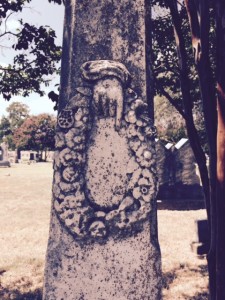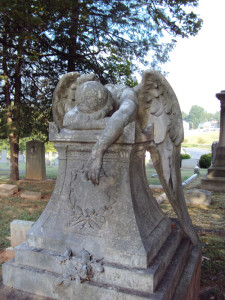
An unusual obelisk found at East Mount Cemetery in Greenville, Texas. Usually the hand and finger are pointed upward toward Heaven, but this indicates a woman holding a wreath full of mourning flowers.
November 1st was All Saints Day or Dia de Muertos. It is a time to honor those who are dead, hence the name Day of the Dead. At Kavanaugh Church here in Greenville, someone will read the names of those added to our Golden Book of the Dead. A red rose will be placed on the altar in the person’s honor. In Mexico it is a special time to visit cemeteries, much like we do on Memorial Day. It is a time to remember our family and friends who have departed in the past year.
Many communities hold Cemetery Walks at this time of the year. Usually, several people in the community are asked to portray one of the earliest settlers, a noted resident, or the sweetest lady who ever lived in the town. The portrayers sit beside the tombstone of the person they represent. When a group stops at the grave, the portrayer stands and gives a short talk about their person and then sits down. At that point the group moves on to the next site.
Costume apparel for the time period and a short scripted speech are created either by the portrayer or some local person. It is a unique and interesting means of presenting local history to the community.
I went on a Cemetery Walk in Franklin, Tennessee, on a hot July day a few years ago. Franklin was the site of one of the last Civil War battles. It was at one time a small town south of Nashville on the Natchez Trace. The guide was an interesting entrepreneur who made a business of treating tourist to an unusual piece of history.
While it is an excellent way to spread local history to both citizens and residents, I personally prefer to view a cemetery as an outdoor sculpture exhibit. Look closely at late 19th and early 20th century tombstones. They are truly works of art.
Traditionally a hand pointed upward indicated the hope of arrival in Heaven. Recently I found a most interesting obelisk at East Mount Cemetery. It shows a hand, probably female, holding a wreath of flowers. But instead of pointing up, the index finger on the hand is pointing down. Hmmm!
One tombstone rarely seen in this part of Texas is Life Cut Short. Again, a simple, unadorned obelisk in found at the grave. But the top of this obelisk appears to be broken off, indicating “a life cut short.” One of the earliest of these markers can be found at the grave of Meriwether Lewis, leader of the Lewis and Clark Expedition organized by President Thomas Jefferson to explore the Louisiana Purchase. Lewis died suddenly and quite unexpectedly along the Natchez Trace. Many believe he was murdered while the official thought is that he committed suicide.

Stellar example of Weeping Angel found at Old Presbyterian Cemetery in Lynchburg, Virginia. The face is even intricately carved.
At Memoryland, also in Greenville, is a version of the Weeping Angel where a feminine angel appears to weep over the headstone. At all three of the cemeteries in Greenville and numerous ones in Hunt County Geesey tombstones are evident. John Geesey made a unique type of grave marker, a sheet of cement that fit over the grave with a bronze plaque at the headstone. They are quite easy to identify.
As you pass by a cemetery, take time to look at the various old statuary found there.
